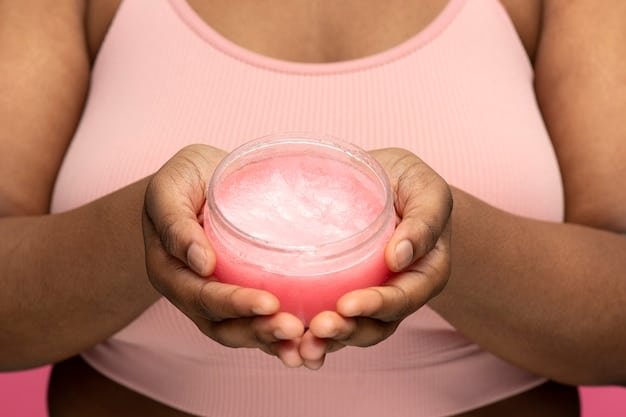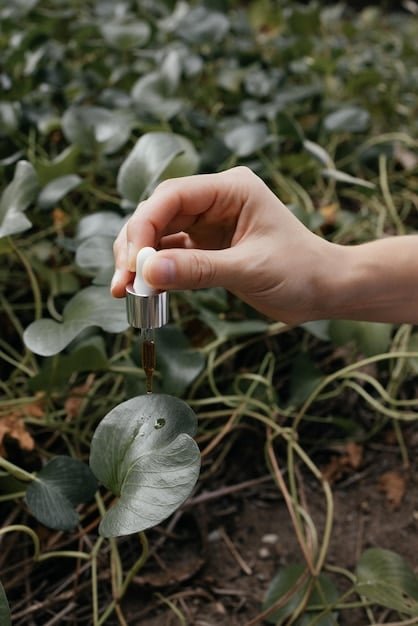Decoding Skincare Labels: Your 2025 Ingredient Guide

Decoding skincare labels in 2025 involves understanding evolving ingredient technologies, sustainability concerns, and personalized skincare approaches for informed consumer choices and effective skincare routines.
Navigating the world of skincare can feel like deciphering a secret code. In 2025, understanding what those ingredients on your skincare labels *really* mean is more important than ever. This guide to decoding skincare labels: what those ingredients really mean in 2025, will give you the knowledge you need to make informed choices and achieve your best skin.
Decoding Common Skincare Ingredients in 2025
Skincare ingredients are constantly evolving. Knowing the function and effects of common ingredients ensures you’re using products that are effective for your skin type and concerns.
Hyaluronic Acid: Hydration Hero
Hyaluronic acid remains a hydration staple, however cutting-edge formulations now incorporate varying molecular weights for deeper penetration and longer-lasting moisture retention.
Retinoids: The Anti-Aging Powerhouse
Retinoids, like retinol and retinaldehyde, are still celebrated for their anti-aging abilities. Newer derivatives prioritize gentler delivery systems to minimize irritation while maximizing efficacy.
Vitamin C: Brightening and Protection
Vitamin C continues to brighten skin and protect against environmental damage. Look for stable forms like tetrahexyldecyl ascorbate or ascorbyl glucoside for enhanced performance.
- Hyaluronic Acid: Essential for hydration, drawing moisture to the skin.
- Retinoids: Boost collagen production and reduce fine lines and wrinkles.
- Vitamin C: Provides antioxidant protection, brightens skin, and evens skin tone.
Understanding these fundamental ingredients empowers consumers to make conscious choices that address their unique skin needs.
The Rise of Sustainable and Ethical Ingredients
Consumers are increasingly demanding transparency and sustainability from skincare brands. Ethical sourcing and environmentally friendly practices are becoming integral to the industry.

Eco-Friendly Packaging
Brands are embracing recyclable, biodegradable, and refillable packaging options to reduce waste and environmental impact. Look for certifications like FSC (Forest Stewardship Council) on paper products.
Cruelty-Free Certifications
Ensuring products are cruelty-free means they haven’t been tested on animals. Certifications like Leaping Bunny provide assurance that products meet ethical standards
Upcycled Ingredients
Upcycled ingredients, derived from by-products of other industries, are gaining popularity. These ingredients reduce waste and offer unique skincare benefits. Coffee grounds, fruit extracts, and plant oils are common examples.
Consciously choosing skincare products with sustainable and ethical ingredients supports a healthier planet and promotes responsible consumerism.
Decoding “Clean Beauty”: What Does It Really Mean?
“Clean beauty” is a popular term; however, its definition can vary. Understanding what it means and what to look for helps you make informed decisions.
Understanding the Terminology
“Clean beauty” generally refers to products formulated without ingredients considered harmful or irritating. However, there’s no standardized definition, so it’s essential to do your research.
Ingredients to Avoid
Common ingredients to avoid in “clean beauty” products include parabens, phthalates, sulfates (SLS/SLES), synthetic fragrances, and formaldehyde-releasing preservatives.
Third-Party Certifications
Third-party certifications like EWG Verified and COSMOS can help you identify products that meet stringent clean beauty standards. These certifications provide an added layer of assurance and transparency.
- Transparency: Brands disclose all ingredients and their purposes.
- Minimalism: Products contain fewer ingredients, reducing the risk of irritation.
- Responsibility: Brands commit to continuous improvement and consumer safety.
Decoding “clean beauty” involves critical evaluation and alignment with your personal values regarding health and environmental impact.
The Impact of Personalized Skincare in 2025
Personalized skincare is becoming more sophisticated, using genetic testing, AI-powered analysis, and customized formulations to address individual skin needs.

Genetic Testing for Skincare
Genetic testing can reveal predispositions to certain skin conditions, allowing for targeted product selection. Understanding factors like collagen production, antioxidant capacity, and inflammation sensitivity can guide your skincare routine.
AI-Powered Skin Analysis
AI-powered apps and devices analyze skin concerns using advanced algorithms, offering personalized product recommendations and routines. These tools consider factors like hydration levels, pore size, and wrinkle depth.
Custom Formulations
Custom skincare brands create personalized formulas based on your skin type, concerns, and lifestyle factors. These formulations often contain concentrated active ingredients tailored to your specific needs.
Personalized skincare exemplifies a shift towards targeted, effective, and efficient routines, optimizing results while minimizing unnecessary exposure to ingredients.
Demystifying Acid Exfoliants: AHAs, BHAs, and PHAs
Chemical exfoliants are essential for revealing smoother, brighter skin. Understanding the differences between AHAs, BHAs, and PHAs allows you to choose the right exfoliant for your skin type.
AHAs (Alpha Hydroxy Acids)
AHAs like glycolic and lactic acid exfoliate the skin’s surface, improving texture and tone. They’re suitable for normal to dry skin and can address concerns like dullness and hyperpigmentation.
BHAs (Beta Hydroxy Acids)
BHAs like salicylic acid penetrate pores to dissolve oil and debris, making them ideal for oily and acne-prone skin. BHAs also have anti-inflammatory properties, reducing redness and breakouts.
PHAs (Poly Hydroxy Acids)
PHAs like gluconolactone are gentler exfoliants with larger molecules that don’t penetrate as deeply. They’re suitable for sensitive skin and offer hydrating benefits in addition to exfoliation.
- AHAs: Best for dry and aging skin.
- BHAs: Ideal for oily and acne-prone skin.
- PHAs: Suitable for sensitive skin.
Selecting the right acid exfoliant involves understanding your skin type and concerns, and considering the frequency and concentration of use to avoid irritation.
Future Trends: Skincare Innovation in 2025
Skincare innovation continues to advance, integrating technologies and approaches that enhance efficacy, sustainability, and personalization.
Biotechnology and Skincare
Biotechnology is revolutionizing skincare with ingredients derived from cellular processes and microorganisms. These ingredients offer unique benefits like enhanced hydration, collagen synthesis, and skin repair.
Neurocosmetics
Neurocosmetics target the interaction between the skin and nervous system to reduce stress-induced skin issues. Ingredients like neuropeptides and plant extracts aim to calm inflammation, enhance relaxation, and improve overall skin health.
The Metaverse and Skincare
The metaverse is creating new opportunities for skincare brands to engage with consumers through virtual consultations, personalized product design, and immersive experiences. Virtual try-on tools will allow consumers to test products before purchasing.
Staying informed about future trends ensures you remain at the forefront of skincare innovation, benefiting from the most effective and personalized solutions available.
| Key Aspect | Brief Description |
|---|---|
| 🌱 Sustainable Ingredients | Ethical sourcing and eco-friendly packaging are increasingly important. |
| 🔬 Personalized Skincare | Genetic testing and AI analysis offer tailored skincare solutions. |
| 🧪 “Clean Beauty” | Focus on products without potentially harmful ingredients, seeking transparency. |
| 💡 Acid Exfoliants | Understanding AHAs, BHAs, and PHAs for effective exfoliation based on skin type. |
FAQ
▼
Look for retinoids (like retinol), vitamin C, peptides, and hyaluronic acid. Retinoids boost collagen, vitamin C protects against damage and peptides promote skin repair.
▼
If you have oily or acne-prone skin, opt for BHAs like salicylic acid. For dry or aging skin, AHAs like glycolic or lactic acid are recommended. Sensitive skin benefits from PHAs.
▼
“Cruelty-free” means the product and its ingredients have not been tested on animals at any stage of development. Look for certifications like Leaping Bunny.
▼
Look for eco-friendly packaging (recyclable, biodegradable), certifications like FSC, and brands that disclose their ethical sourcing practices. Upcycled ingredients also indicate sustainability.
▼
Personalized skincare addresses individual skin needs based on factors like genetics, skin analysis, and lifestyle. This approach ensures more targeted and effective skincare routines and results.
Conclusion
In 2025, decoding skincare labels involves understanding ingredient technologies, sustainability, and personalization. Armed with this knowledge, you can make informed choices that support your skin’s health and align with your values for products that promote transparency and environmental responsibility.





